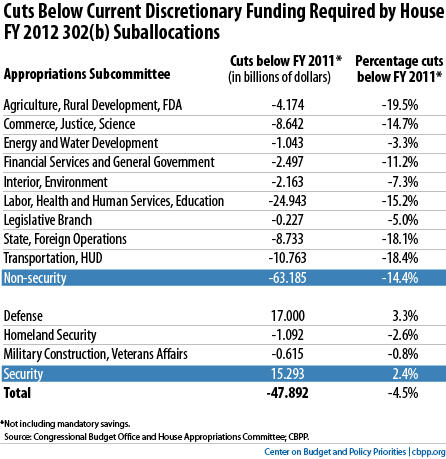off the charts
POLICY INSIGHT
BEYOND THE NUMBERS
BEYOND THE NUMBERS
Proposed Spending Limits for 2012 Would Require Very Severe Cuts — Even Larger than Advertised
Receive the latest news and reports from the Center
The limits on discretionary (annually appropriated) funding for fiscal year 2012 that House Appropriations Committee Chairman Hal Rogers (R-KY) proposed this week — the so-called 302(b) suballocations — would restrict total funding for non-security discretionary programs to $376 billion. That’s $63 billion (14.4 percent) below the austere 2011 level and $103 billion (21.5 percent) below the amount provided for 2010, adjusted for inflation.
In other words, total resources for programs not controlled by the Defense, Homeland Security, and Military Construction-Veterans Affairs subcommittees — ranging from aid to state and local governments for primary and secondary education to funding for the FBI, EPA, and National Institutes of Health — would be cut in real terms by more than one-fifth in just two years.
In contrast, total funding for programs controlled by the three security subcommittees would rise by $15 billion (2.4 percent) above the 2011 level (see table).

The cuts described here are somewhat larger than those in Chairman Rogers’ press release, which are calculated relative to the amounts “scored” (i.e., officially tabulated) for the final appropriation bill for 2011 (H.R. 1473). Those scores, however, total $17.5 billion below the actual discretionary funding available for 2011 because they reflect $17.5 billion in savings that the various subcommittees generated by cutting mandatory (i.e., non-appropriated) programs. (The levels of actual discretionary funding enacted for 2011 are $1.067 trillion for all programs and $439 billion for non-security programs.) Since Chairman Rogers’ press release understates actual 2011 funding levels, it understates the cuts needed to meet the proposed limits for 2012.
Of course, the cuts required to meet the proposed 2012 limits would be smaller if appropriation bills for 2012 also include some reductions in mandatory programs. But those bills will not likely contain anywhere close to $17.5 billion in mandatory savings.
The proposed limits for individual subcommittees are subject to change because the budget resolution on which they are based (which sets an overall limit for discretionary funding) has passed the House but not the Senate. But the total amount of discretionary funding that Congress can appropriate for 2012 will not be higher unless the House votes to increase that amount above what the House-passed budget resolution will allow.